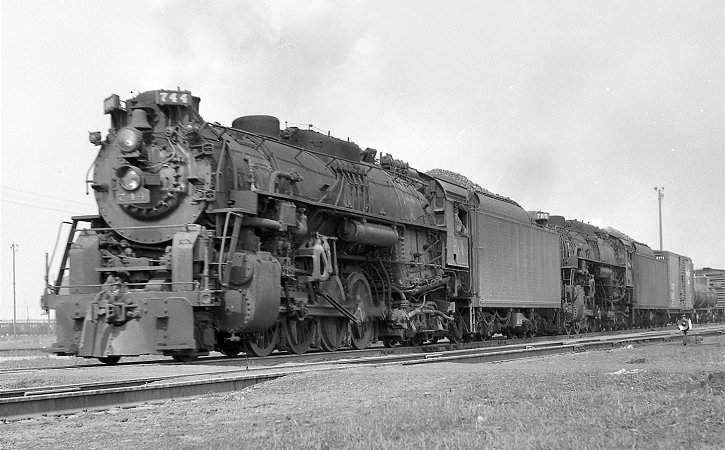Introduction
The picture above shows just one of the reasons for the success of the Nickel Plate Road (NKP). Some would say the Berkshires of the Nickel Plate were the number one reason for the operational and financial success of the NKP. Whatever your ranking of the role the Berkshires played in the success of the Nickel Plate, most railroad and steam locomotive enthusiasts agree that the Berkshire type of locomotives – regardless of which railroad owned them and regardless of the design variations in this class of locomotives – were solid performers and more than capable of the work for which they were designed. Let’s take a look at the Berkshire class of locomotives on the Nickel Plate Road.
Purpose
A picture of double-headed Berkshires both rare and an exception to the rule of how the Nickel Plate used these locomotives. Consider why they were purchased in the first place – speed and power. Speed; so as to compete for business against the Pennsylvania and New York Central railroads and Power; so as to require only one Berkshire locomotive (and more important, only one crew) for each train going from Point A to Point B. In this age of multi-unit diesel lash-ups with remote control of multiple diesels from the lead engine, it may not occur to us that each steam locomotive needed a full crew for operation. While we may love the look of multiple steam engines plying their trade across the plains or up the mountains, the fact remains that railroads, then and now, are in business to make a profit; not to provide photo opportunities for railroad enthusiasts. In short, every locomotive has to earn its keep. As for this photo of double-headed Berkshires – the most common reason for seeing two or even three Berkshires pulling a train is to balance power at one division point or another.
A Few Words on Naming Steam Engines
To borrow from the “Why a Duck?” routine of the Marx Brothers — “Why a Berkshire?” or “Why a Mikado”? Why are steam locomotives usually referred to be a name, rather than model number?
The first place to look for that answer is on the high seas. There is a long heritage of naming seafaring vessels. Some ship names, for good or ill, are more memorable than others. The second place to look, particularly in the case of steam locomotives is a map of the routes they plied. For example, while the Nickel Plate Berkshires spent their lives on the (relatively) flat lands of Ohio, Indiana and Illinois; they were given their sea (excuse me, land) trials in the Berkshire mountains of Eastern New York/Western Massachusetts. Other examples can be found in the naming of the Hudson, Niagara, Texas and Pacific. Lastly, it seems to be part of human nature to name everything around us. While George Lucas may lean towards alpha-numerics (THX 1138, C3PO, R2D2, etc.), most people are fans of names.
Performance
Returning to the Berkshire class of locomotives; in particular those purchased by and running on the Nickel Plate Road – their performance, and therefore, their usefulness in the business of generating profits for the Nickel Plate more than justified both the original purchase price of the locomotive and their ongoing maintenance costs. The Nickel Plate was one of the last railroads to use steam locomotives in regular revenue service. I leave it to you to look up the story of the Nickel Plate testing diesel replacements for the Berkshires.
Legacy
Sure, steam locomotives make no economic sense these days. But one need only look at the YouTube videos of NKP 765 in action to know that economics is not the only factor in running steam locomotives.

